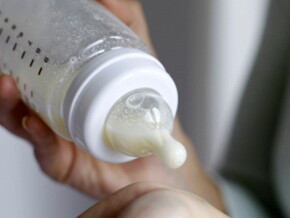
When to start feeding your baby solids
Watch for these readiness signs before introducing your baby’s first food:
- The ability to support the head and neck.
- The strength to sit without support.
- An interest in what you’re eating.
- A healthier-than-usual appetite.
- The ability to keep food in the mouth without using the tongue to push it out.
If you aren't sure whether your baby is ready to start on solid foods, talk to your doctor and find out more about first-year feeding here.
These indicators mean it may be time to complement (yes, complement — not substitute) breast milk or infant formula with solid foods. Breast milk should still make up about 80% of your little one’s diet.1 Looking for more information? See when to start solid foods for babies.
How to introduce first foods to your baby
9 tips to help transition your baby to solids
1. Start with single-ingredient foods
Make your baby’s first food a single-ingredient, iron-rich food, like meat, meat alternatives or an iron-fortified baby cereal, as the iron stores they’ll get in utero start to deplete around six months.
Gradually increase the number of times a day that you offer them solid foods and continue to offer iron-rich foods regularly.
You can progress from single-ingredient purees to richer tastes and textures and to a variety of nutritious foods.

Gerber Cereals
2. Introduce new foods in the morning
You may find that morning is the best time to offer new foods because your baby is more likely to be hungry, happy and receptive to trying new things.
Plus, you’ll have the full day to monitor for food intolerances or allergic reactions.
3. Offer small amounts at the beginning
Start slowly, with one to two teaspoons of food, and see how your baby does. You can offer more if they seem hungry and interested — it’s all they need for the first go-round.
4. Pay attention to texture
Your baby’s first food should be smooth in consistency and lump-free to prevent choking. Mixing solid food with breast milk or with infant formula may help with the consistency and also make it taste more familiar.
Instructions for first feedings with baby cereal: Place one tablespoon of cereal into a bowl and mix with three or four tablespoons of previously boiled, lukewarm water, breast milk or iron-fortified infant formula (depending on the cereal you’re trying). Mix in enough to make a runny mixture.
5. Experiment with temperature
Practice serving foods at different temperatures. But remember, too cold is unenjoyable and too hot is unsafe! Both would likely lead to a negative experience for both you and your baby.
6. Get comfortable using a baby spoon
Dip the tip of a soft slim spoon into the food and offer it to your baby, but don’t force it in.
Wait until they open their mouth.
If they reach for the spoon, let them try it! They may even want to use their fingers to catch the food. You’ll succeed with a bit of patience.
Make mealtime fun: Positive reinforcement works. Saying “Yay! Good job!” in an excited and proud way will make your baby more likely to want to try the food again.
7. Cook everything thoroughly
Babies are more vulnerable than adults are to bacteria that can grow in food. Raw or undercooked meat, poultry/eggs or fish should never be offered to infants or young children.
8. Offer a new food for at least 2 days before introducing another one
In case of an adverse reaction, this delay will help you better identify the culprit. If this happens, stop feeding the food right away and talk to your baby's doctor.
9. Don’t get discouraged — it’ll come
It may take a few days before any food actually makes it into your baby’s tummy. That’s okay!
Eating food is a skill you take for granted, but you had to learn it just as your baby is learning now.
Looking at, touching or smelling the food without eating it is common — these are all senses your baby is still learning.
Continue to pay attention to your baby’s hunger cues so you can breastfeed or formula feed accordingly.
Learn more about your little one's hunger cues here.
Health experts advise not to delay the introduction of any specific solid food beyond six months of age, regardless of family history of allergy. You can introduce peanuts, soy, whole eggs, fish and wheat as you would any other food and monitor for allergic reactions. Consult your doctor if you have concerns about introducing solid foods or about allergies in your baby.
Food for thought:
Always use a spoon, never a bottle, when feeding solids.
- Feeding cues to look out for
- Know your baby is hungry when
- Know your baby is full when
- Healthy food options for your baby
- Common food allergies in babies
- How much should your baby eat for each meal
- Most important nutrients in your baby’s diet
Suggested reading
Foods to avoid
These foods are not appropriate for your little ones at the early stages of food introduction:
Choking hazards
Foods that are hard or crunchy, small and round shaped, or sticky can block your baby or small child’s airway.
Be sure to prepare foods according to your child’s age and their ability to chew and swallow. And, you should always supervise your baby while they are eating.
Whole (3.25%) cow’s milk
Whole (homogenized) cow’s milk (3.25% milk fat) can be introduced between 9 and 12 months of age, once your baby is eating a variety of iron-rich foods.
Cow’s milk is low in iron, can take up room in your baby’s tummy and displace iron-rich foods, and can even inhibit iron absorption.
See why your baby isn't ready for cow's milk right away when they start solid foods.
Honey
Do not feed honey (pasteurized or unpasteurized) to infants under one year of age. Honey, including pasteurized honey, has been linked to a type of food poisoning called infant botulism, and should not be added to baby foods or used on soothers, nipples or teething toys.
Sugar & salt
Avoid adding sugar and salt when preparing food for your baby. This will help your little one fully experience new foods and develop a taste for its natural flavours.
Sweetened beverages
Choose fruits and vegetables over fruit juice and avoid other sweetened beverages. You can also offer water regularly.
For older babies no longer eating breastmilk or formula, their main milk source should be whole cow’s milk.
Plant-based beverages don’t offer enough nutrition for toddlers under two, and raw or unpasteurized beverages are not safe for babies and toddlers.
For more information on what to avoid, see Safe Food Handling: Making safe food choices for your baby.
Wondering which new foods to try? For more on foods appropriate for your little one, check out the Nestle Baby Feeding Guide.
References
Dietitians of Canada. Introducing Solid Food to Your Baby.
https://www.unlockfood.ca/en/Articles/Breastfeeding-Infant-feeding/Introducing-solid-food-to-your-baby.aspx Accessed July 8, 2020
Health Canada, Canadian Paediatric Society, Dietitians of Canada, & Breastfeeding Committee for Canada. Nutrition for Healthy Term Infants: Recommendations from 6 to 24 months. 2014.























